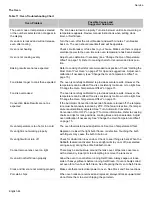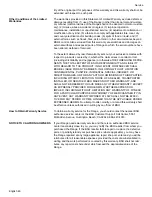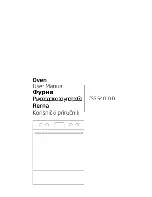
Cleaning and Maintenance
English 38
Self Cleaning the Oven
The oven features a self-cleaning function that eliminates the manual labor
involved with cleaning your oven. During self-cleaning, the oven uses a very high
temperature to burn away food soil and grease.
•
Wipe out excessive spillage before self-cleaning the oven.
•
Do not clean parts or accessories in the self-clean oven.
•
It is common to see smoke and/or an occasional flame-up during the Self-
Clean cycle, depending on the content and amount of soil remaining in the
oven. If a flame persists, turn off the oven and allow it to cool before opening
the door to wipe up the excessive food soil.
•
The oven door locks at the beginning of the self-clean cycle.
•
The oven light does not operate during this mode.
•
During Self-Clean, the kitchen should be well ventilated to help eliminate
odors associated with Self-Clean. Odors will lessen with use.
•
Four hours is the preset length of cleaning. The range can also be set to clean
for 3 or 5 hours.
•
The mode automatically stops at the end of the clean hours.
•
When the oven cools after cleaning, the automatic door lock will release and
the door can be opened.
•
To cancel or stop while the mode is operating, press OFF.
•
The door will not unlock until the oven reaches a safe temperature.
Preparing the Oven for Self Clean
WARNING
A flexible door gasket is necessary for a good seal. Do not clean, rub,
damage or move the gasket.
1. Remove all utensils and bakeware.
2. Remove oven racks. If oven racks are left in the oven during the self-clean
cycle, they will permanently lose the shiny finish and change to a dull dark fin-
ish. See Oven Cleaning Chart for proper care.
3. Wipe up excessive spills, soil, and grease before self-cleaning the oven.
Excess grease will cause flames and smoke inside the oven during self-clean-
ing.
Porcelain Surfaces
Immediately wipe up acid spills like fruit juice, milk and tomatoes with a dry towel. Do not use a
moistened sponge/towel on hot porcelain. When cool, clean with hot sudsy water or apply Bon-
Ami® or Soft Scrub® to a damp sponge. Rinse and dry. For stubborn stains, use soap filled
pads. It is normal for porcelain to show fine lines with age due to exposure to heat and food soil.
Stainless Surfaces
Always wipe or rub with grain. Clean with a soapy sponge then rinse and dry, or wipe with Fan-
tastik® or Formula 409® sprayed onto a paper towel. Protect and polish with Stainless Steel
Magic® and a soft cloth. Remove water spots with a cloth dampened with white vinegar. Use
Bar Keeper’s Friend® to remove heat discoloration.
Plastic & Controls
When cool, clean with soapy water, rinse and dry.
Table 9: Oven Cleaning Chart
Part
Recommendations











































